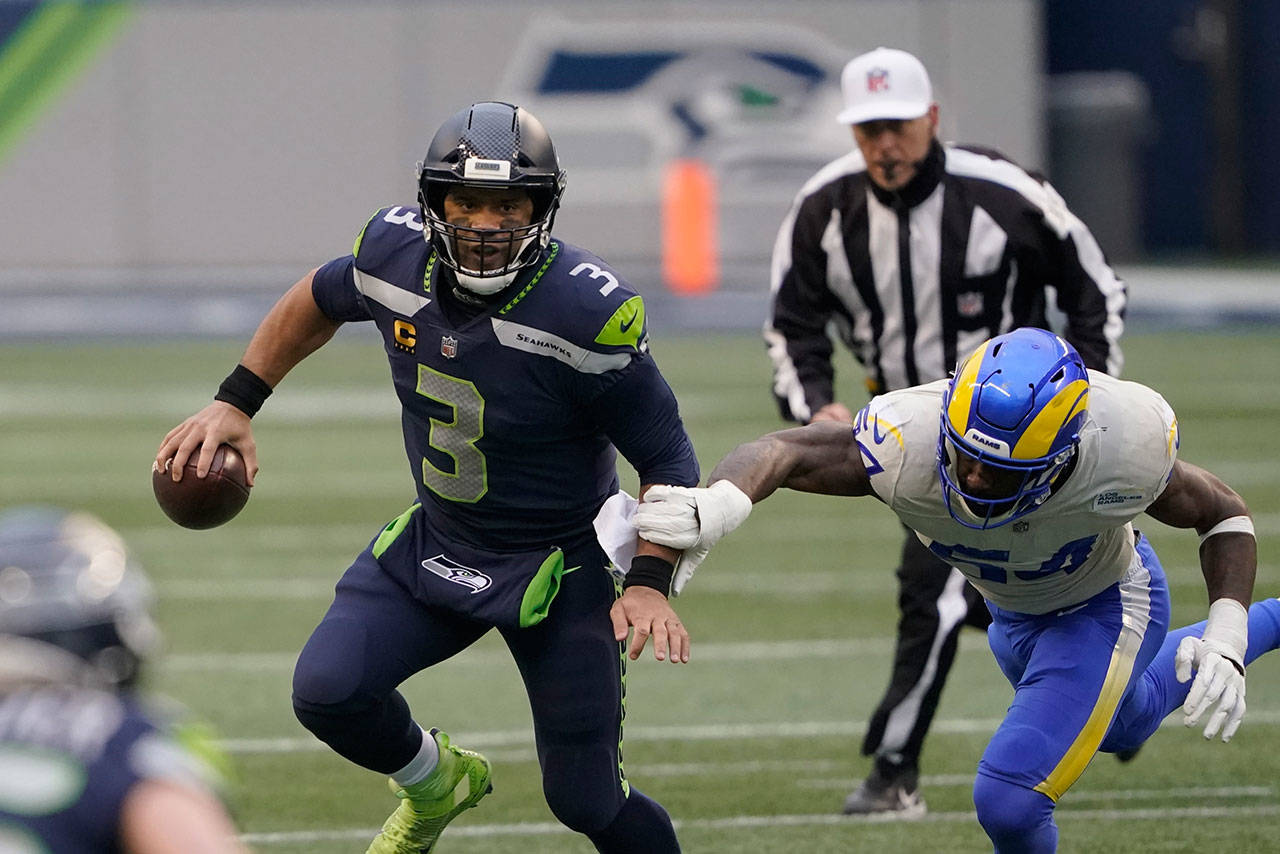The Seattle Seahawks thought they’d be playing over the weekend.
The Seahawks finished the regular season 12-4, won the NFC West championship to earn the conference’s No. 3 seed to the playoffs, and had Super Bowl aspirations. However, Seattle was upset by the Los Angeles Rams 30-20 on Jan. 9 in their wild-card matchup.
With a little time for reflection, here’s the Seahawks’ final report card for the 2020 season:
OFFENSE
Points per game: 28.7 (eighth in the NFL)
Yards per game: 369.5 (17th)
There were a lot of good numbers put up by Seattle this season. Seahawks quarterback Russell Wilson broke the franchise record by throwing 40 touchdown passes. Receiver DK Metcalf busted out in a big way in his second year, breaking the team record for receiving yardage in a season (1,303), while fellow wideout Tyler Lockett became the first player in team history to hit triple figures in receptions. The net result was a new franchise record in scoring.
But while the final numbers show the Seahawks as an above-average offense, one also must take into account the unit’s degeneration as the season progressed. After averaging 34.3 points and 415 yards through the first eight games, those numbers dropped to 23.1 points and 324.0 yards during the final eight contests. Wilson’s passer rating sank from 117.1 during the first half to 91.3 during the second half as all talk of Wilson as the league’s MVP evaporated. Seattle never got back on track offensively, which was glaring in the playoff loss to the Rams, and the fact the team decided to “part ways” with offensive coordinator Brian Schottenheimer reinforces the notion that not all was well with the offense.
Grade: C-
DEFENSE
Points allowed per game: 23.2 (15th)
Yards allowed per game: 380.6 (22nd)
The defense was the flip side of the coin to the offense. Seattle’s defense was a disaster during the first half of the season as the Seahawks gave up huge numbers of points and was on track to shatter the NFL record for passing yards allowed. The main question was whether Seattle’s offense was good enough to overcome its historically bad defense.
But things turned around in a big way during the second half of the season. Strong safety Jamal Adams returned from a groin injury, defensive end Carlos Dunlap was acquired in a midseason trade, and they helped turn the Seahawks’ biggest question mark coming into the season — the pass rush — into a strength. Seattle finished seventh in the league with 46 sacks. Over the final seven games, Seattle allowed just 15.0 points per game, which would have been the league’s best number, and gave up just 293.4 yards, which would have been second.
One can question just how good the defense actually was, as Seattle didn’t face a good offense down the stretch. But at least the defense improved as the season went along.
Grade: C+
SPECIAL TEAMS
Seattle’s special teams were on point all season long. Kicker Jason Myers didn’t miss a field goal, going 24-for-24 and breaking the franchise record by making a 60-yarder. Punter Michael Dickson was second in the league in punting (49.6 yards per punt) and first in punts inside the 20 (32) as he showed off an amazing ability to angle punts to the sideline so the returner caught it just as he stepped out of bounds. The switch to D.J. Reed as the primary kick and punt returner gave the Seahawks a home-run threat. And Seattle’s kick coverage teams were solid as the Seahawks did not allow a return touchdown.
The only blemishes on the special teams’ ledger were Myers’ four missed extra points and the fact that Reed fumbled a punt return at the absolute worst time during Seattle’s playoff loss.
Grade: A-
COACHING
During the first half of the season, Pete Carroll finally heeded the call of the fans and “let Russ cook.” It worked to tremendous effect as early down passing, deep balls and aggressive decisions on fourth down made Seattle the highest-scoring team in the NFL. However, a rash of mid-season turnovers seemed to spook Carroll, and he reverted to his conservative run-first self during the second half, and it didn’t work. There were also some high-profile examples of mismanagement affecting the outcome of games.
Things went better on the defensive side of the ball. It took a while for the coaches to figure out how best to deploy Adams’ unique abilities as a pass rusher, but by midseason they’d found the right formula and Adams finished with 9.5 sacks to break the NFL record for sacks in a season by a defensive back, despite missing four games.
One big point in Seattle coaches’ favor was successfully navigating the coronavirus pandemic. The Seahawks were the league’s only team to make it through the season without a player testing positive.
Grade: C
OVERALL
This was one of the best regular seasons in franchise history. The Seahawks won 12 games for just the fifth time in the organization’s 45 years. Seattle hung a division banner, the team’s first since 2016 and 11th all-time.
But the way the season ended left a sour taste. The offensive struggles in the second half were painful to watch, especially given Wilson and company showed exactly what they were capable of early in the season. And being eliminated by the Rams, whom Seattle beat two weeks earlier and who were forced to use a quarterback with a broken thumb, made for an unsatisfying end. The record and the division title are things that can’t be taken away, but neither can Seattle’s 3-5 playoff record since its Super Bowl loss to New England at the end of the 2014 season.
Grade: B-
Talk to us
> Give us your news tips.
> Send us a letter to the editor.
> More Herald contact information.

























